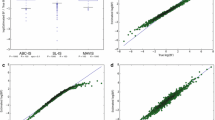Abstract
Pairwise interacting point processes are commonly used to model spatial point patterns. To perform inference, the established frequentist methods can produce good point estimates when the interaction in the data is moderate, but some methods may produce severely biased estimates when the interaction in strong. Furthermore, because the sampling distributions of the estimates are unclear, interval estimates are typically obtained by parametric bootstrap methods. In the current setting however, the behavior of such estimates is not well understood. In this article we propose Bayesian methods for obtaining inferences in pairwise interacting point processes. The requisite application of Markov chain Monte Carlo (MCMC) techniques is complicated by an intractable function of the parameters in the likelihood. The acceptance probability in a Metropolis-Hastings algorithm involves the ratio of two likelihoods evaluated at differing parameter values. The intractable functions do not cancel, and hence an intractable ratio r must be estimated within each iteration of a Metropolis-Hastings sampler. We propose the use of importance sampling techniques within MCMC to address this problem. While r may be estimated by other methods, these, in general, are not readily applied in a Bayesian setting. We demonstrate the validity of our importance sampling approach with a small simulation study. Finally, we analyze the Swedish pine sapling dataset (Strand 1972) and contrast the results with those in the literature.
Similar content being viewed by others
References
Baddeley A. and Turner R. 2000. Practical maximum pseudolikelihood for spatial point patterns. Australian and New Zealand Journal of Statistics 42: 283–322.
Berthelsen K.K. and Møller J. 2001. Perfect simulation and inference for spatial point processes. Technical report R-01-2009, Department of Mathematical Sciences, Aalborg University.
Brooks S. and Gelman A. 1998. General methods for monitoring convergence of iterative simulations. Journal of Computational and Graphical Statistics 7(4): 434–455.
Chen M.-H. and Shao Q.-M. 1997. On Monte Carlo methods for estimating ratios of normalizing constants. The Annals of Statistics 25: 1563–1594.
Degenhardt A. 1999. Description of tree distribution patterns and their development through marked Gibbs processes. Biometrika 74: 763–770.
Diggle P.J., Fiksel T., Grabarnik P., Ogata Y., Stoyan D. and Tanemura M. 1994. On parameter estimation for pairwise interaction point processes. International Statistical Review 62: 99–117.
Fiksel T. 1984. Estimation of parameterized pair potentials of marked and unmarked Gibbsian point processes. Elektron. Inform. Kybernet. 20: 270–278.
Fiksel T. 1988. Estimation of interaction potentials of Gibbsian point processes. Math. Operationsf. Statist. Ser. Statist. 19: 77–86.
Gelman A. and Rubin D.B. 1992. Inference from iterative simulation using multiple sequences. Statistical Science 7: 457–472.
Geweke J. 1992. Evaluating the accuracy of sampling-based approaches to calculating posterior moments. In: Bernardo J.M., Berger J.O., Dawid A.P. and Smith A.F.M. (Eds.), Bayesian Statistics 4. Clarendon Press, Oxford, UK.
Geyer C.J. 1999. Likelihood inference for spatial point processes. In: Kendall W., Barndorff-Nielsen O. and van Lieshout M.N.M. (Eds.), Stochastic Geometry: Likelihood and Computation. Chapman and Hall/CRC Press, London, Boca Raton.
Geyer C.J. and Møller J. 1994. Simulation procedures and likelihood inference for spatial point processes. Scandinavian Journal of Statistics 21: 359–373.
Gilks W.R., Richardson S. and Spiegelhalter D.J. 1996. Markov Chain Monte Carlo in Practice. Chapman and Hall, London.
Hastings W.K. 1970. Monte Carlo sampling methods using Markov chains and their applications. Biometrika 57: 97–109.
Heikkinen J. and Penttinen A. 1999. Bayesian smoothing in the estimation of the pair potential function of Gibbs point patterns. Bernoulli 5: 1119–1136.
Metropolis N., Rosenbluth A.W., Rosenbluth M.N., Teller A.H. and Teller E. 1953. Equations of state calculations by fast computing machines. Journal of Chemical Physics 21: 1087–1091.
Møller J. and Nicholls G.K. 1999. Perfect simulation for sample-based inference. Technical report R-99-2011, Department of Mathematical Sciences, Aalborg University.
Ogata Y. and Tanemura M. 1981. Estimation of interaction potentials of spatial point patterns through the maximum likelihood procedure. Annals of the Institute of Statistical Mathematics 33: 315–338.
Propp J.G. and Wilson D.B. 1996. Exact sampling with coupled Markov chains and applications to statistical mechanics. Random Structures and Algorithms 9: 223–252.
Ripley B.D. 1981. Spatial Statistics. John Wiley and Sons, New York.
Ripley B.D. 1988. Statistical Inference for Spatial Processes. Cambridge University Press.
Smith A.F.M. and Gelfand A.E. 1992. Bayesian statistics without tears: Asampling-resampling perspective. The American Statistician 46: 84–88.
Strand L. 1972. A model for stand growth. IUFRO Third Conference Advisory Group of Forest Statisticians Institut National de la Recherche Agronomique. Paris, pp. 207–216.
Strauss D. 1975. A model for clustering. Biometrika 62: 467–475.
Stoyan D. and Penttinen A. 2000. Recent applications of point process methods in forestry statistics. Statistical Science 15: 61–78.
Takacs R. 1986. Estimator for the pair-potential of a Gibbsian point process. Math. Operationsf. Statist. Ser. Statist. 17: 429–433.
Venables W.N. and Ripley B.D. 1994. Modern Applied Statistics with S-Plus. Springer-Verlag, New York.
Author information
Authors and Affiliations
Rights and permissions
About this article
Cite this article
Bognar, M.A., Cowles, M.K. Bayesian inference for pairwise interacting point processes. Statistics and Computing 14, 109–117 (2004). https://doi.org/10.1023/B:STCO.0000021409.73461.b9
Issue Date:
DOI: https://doi.org/10.1023/B:STCO.0000021409.73461.b9




